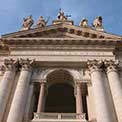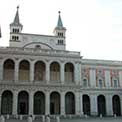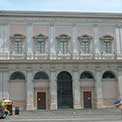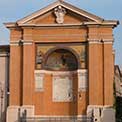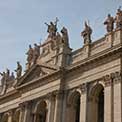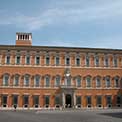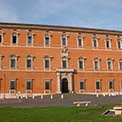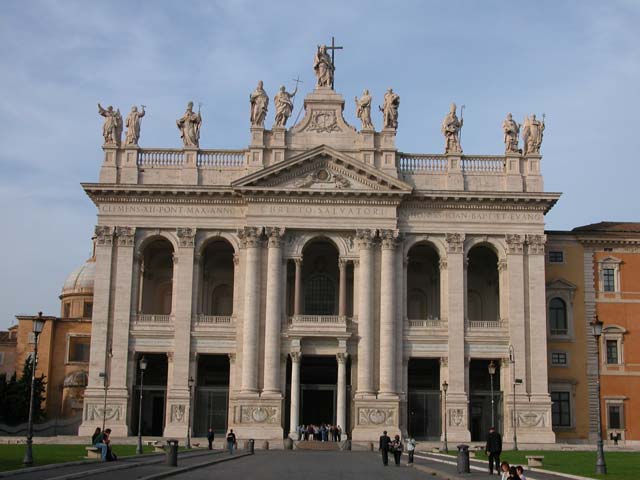
BASILICA* DI S.GIOVANNI LATERANO,
This cathedral is the first and principal temple of Rome, and of the Catholic world. It is called Basilica Custantiniana, because Constantino the Great founded it; Basilica Lateranense, because built on the spot where the palace of Plauzio Laterano stood; del Salvatore, because dedicated by Pope St. Silvester to our Saviour; Basilica Aurea, from the precious gifts that enrich it; and lastly, Basilica S. Giovanni, because it was dedicated to St. John the Baptist and St. John the Evangelist. It is very celebrated on account of the twelve councils which have been held there.
This cathedral, after standing ten centuries, by means of several repairs under different popes, was almost entirely burnt in 1308, under Clement V., who held the Apostolical See at Avignon, as well as the adjoining palace, which we mentioned before. The same pope having sent a considerable sum, it was soon rebuilt; and afterwards adorned by Urban V., Alexander VI., and Pius IV., who formed the fine gilt ceiling, and the side front with two steeples. Sixtus V. added the double portico, from the designs of Fontana, in which stands the bronze statue of Henry IV. of France, executed by Nicholas Cordieri. One of the naves was repaired by James della Porta under Clement VIII.; and the middle one under Innocent X., by Boromini.
At length this splendid temple was finished under Clement XII., by Alexander Galilei, who constructed the principal front. It is decorated with four large columns, and six composite pillars, supporting a magnificent entablature: above is a balustrade, on which are ten colossal statues of different Saints, and that of our Saviour in the middle. Between the columns and pillars are five balconies; from the middle one, which is adorned by four columns of granite, the Pope gives his benediction to the people. The entrance to the magnificent portico, winch is sustained by twenty-four marble pillars of the composite order, is by five doors; in this portico is the colossal statue of Constantino the Great, which was found in his baths. There are five doors to the cathedral, The great bronze door is that which was placed in front of the church of St. Adrian in the Forum Romanum ; it is well executed, and was brought to this place during the reign of Alexander VII.; another door is called Holy, because it is only opened during the year of the great jubilee. The basso relievos on the doors are by Bernardino Ludovisi, Maini, and Peter Bracci.
This church has five naves, divided by four rows of pillars; the middle one, as we have already said, was repaired by Borromini, who covered the ancient columns wiih twelve large pillars, which form fiveiarcades on each side, corresponding to so many chapels ; behind each of the large pillars are two small fluted ones, of the composite order, sustaining an entablature which goes all round the church; between the small pillars are twelve niches, each adorned with two columns of antique green marble, in which are placed the colossal marble statues of the Apostles, by the best sculptorsof those limes; St. James the Great, St.Matthew, St. Andrew, and St. John, are by Rusconi; St. Thomas and St. Bartholomew, by M. Le Gros; St. Thaddeus, by Lorenzo Ottoni; St. Simon, by Francis Maratti: St. Philip, by Joseph Mazzuoli; St. James the Less, by Angelo di Rossi; and St. Peter and St. Paul by Stephen Monot.
The Corsini chapel, which is the first to the left on entering the church, is very magnificent; it is of the Corinthian order, and is adorned with beautiful marbles. Clement XII. erected it in honour of St. Andrew Corsini, his ancestor; Alexander Galilei, a Florentine, was the architect. On the altar, between two superb columns of antique green marble, is a mosaic picture of St. Andrew Corsini, copied from the original by Guido.Reni. On the front of this altar are placed two figures, Innocence and Penitence, sculptured by Pincellolti; and above is a basso relievo, representing St. Andrew Corsini defending the Florentine army at the battle of Anchieri. Near the fine mausoleum of Clement XII. is the famous antique urn of porphyry, which was formerly in the portico of Agrippa's pantheon. The bronze statue of the Pope was modelled by Maini; and Charles Monaldi sculptured the two side figures in marble. On the opposite tomb of Cardinal Neri Corsini, uncle to Clement XII., is the Cardinal's statue, with a Genius and Religion seated, works of Maini. In this chapel, also, are four niches in which are marble statues representing the Cardinal Virtues, and on the top of each niche is a basso relievo in marble. The cupola is adorned with gilt stucco, the pavement is covered with fine marbles, and the balustrade is almost entirely formed of gilt bronze.
In the middle of the great nave of the church, is the bronze tomb of Martin V,, of the house of Colonna, who died in 1430. The great arch of this nave is supported by two superb columns of red eastern granite, 36 feet high. The great altar is adorned with four columns of granite supporting a kind of Gothic tabernacle, in which are kept, as the most precious relics, the heads of St. Peter and St. Paul.
There is a fine altar of the holy sacrament, from the designs of Peter Paul Olivieri: it is adorned with a tabernacle constructed of precious stones, and placed between two angels of gilt bronze, and four fine columns of antique green marble. The entablature of gilt bronze, rests on four fluted columns of the same metal; ihey are of the composite order, and 8 feet 11 inches in circumference. Some people imagine they came from Egypt with Augustus; and others that Vespasian brought them from Jerusalem. On the top is the Ascension, painted by Arpino, who is buried in this church; his tomb is behind the gallery, near that of Andrew Sacchi. The other paintings are by Horace Gentileschi, Cesar Nebbia, Baglioni, Paris Nogara, Pomarancio, Novarra, and Bernardino Cesari. Under these paintings are eight marble angels, and in four niches are Elias, sculptured by Mariani; Moses, by Flaminio Vacca ; Aaron, by Silla, a Milanese; and Melchisedech, by Egidio.
The altar of our Saviour, erected by Nicholas IV., and adorned with Mosaic, still exists. The side door of the church is decorated with two fluted columns of antique yellow marble, which support the organ ; they are the finest of that sort known, and are 29 feet high. There are several tombs in this cathedral; the most remarkable is that of Boniface V11L, because it is adorned with a fresco, believed to be by Giotto, which represents that Pope between two Cardinals, announcing publicly the first Jubilee of the holy year 1300.
* According to Vitruvius, the building called Basilica amongst the ancient Romans, consisted of porticos formed of columns, where the public met for transacting business, and in which were apartments for courts of justice. It is not improbable that the first churches were formed of these ancient basilicee. In the early period of Christianity, the term basilica was synonymous with church, and in later times has been applied to a church distinguished by peculiar privileges.
A new picture of Rome and its environs in the form of an itinerary - Di Mariano Vasi -1824

